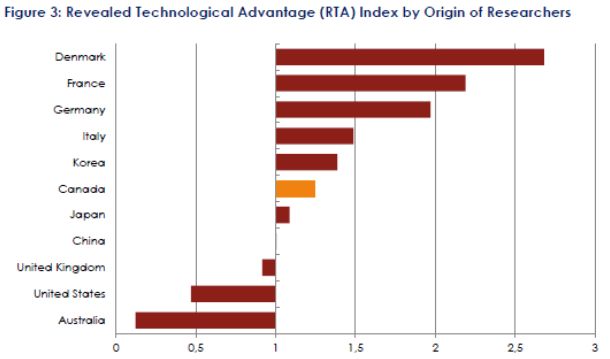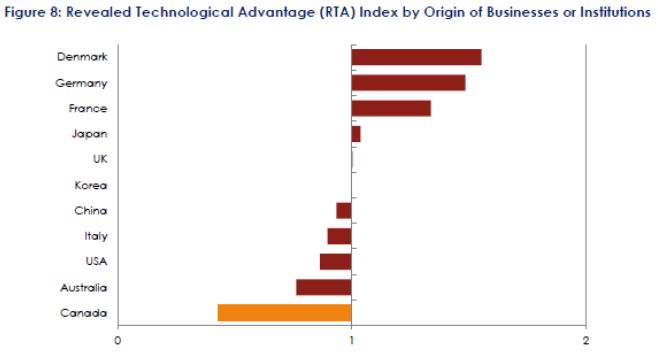The Canadian Intellectual Property Office (CIPO), an agency of Innovation, Science and Economic Development Canada, this week released a report entitled Patented Inventions in Climate Change Mitigation Technologies (CCMTs). Given the swath of government funding and programs devoted to clean technology, this report can be used as a benchmark for future growth.
The report offers tremendous detail into where Canadian researchers and innovators are building patent assets in clean technology. Interestingly, Figure 3 of the Report (reproduced below) shows that Canadian researchers have a relative strength in technical advances within CCMTs when compared to researchers in the other G7 countries (France, Germany, Italy, Japan, United Kingdom, the United States, Korea, China, Australia and Denmark).

Although Canadian researchers are world leaders in CCMTs, the Report also details that the same cannot be said about Canadian businesses. Specifically, Figure 8 of the Report details that Canadian businesses rank below all of the comparator countries in terms of relative specialization in CCMTs.

This poor ranking appears to be consistent across six out of seven of the CCMT categories, including traditional energy, buildings, smart grids, clean energy enablers, renewable energy and transport. The only category where Canadian businesses enjoy a slight relative specialization is carbon capture.

Looking more closely at the top Canadian researchers, Figure 26 shows that eight of the top 22 Canadian researchers are associated with businesses or institutions being centrally located outside of Canada.

While Canadian researchers have therefore contributed to the success of Canadian businesses, the Report suggests international businesses are being successful at attracting Canadian researchers and obtaining patent protection based on their innovation. If this outsourcing of Canadian researchers continues, it will limit Canadian businesses' ability to benefit from CCMT innovation generated domestically. Outsourcing of Canadian talent to international businesses provides international businesses with an edge over Canadian businesses as they compete for resources and limits Canadian businesses' ability to contribute to improving the Canadian economy.
As has been written elsewhere, this is not surprising, and continues to be extremely concerning for the sake of Canada's future prosperity.
Patent trends and statistics can give powerful and important early indications of technological and economic developments. Given some of the compelling insights that the Report details, there is clearly a tremendous opportunity for Canadian businesses to take advantage of Canadian researchers in the CCMT space. CCMT-focused IP strategies, at both the national level and at the company level, need to be developed to ensure that Canadian businesses are benefitting from innovations developed by Canadian researchers.
Further, Canadian businesses need to continue to seek patent ownership in all areas of CCMT. This may be accomplished internally by strategic patent generation or externally by acquiring patent rights through license agreements or assignments. Particularly for CCMT focused superclusters, a CCMT based sovereign patent fund could play an important role in developing and supporting Canadian innovation.
The goal of having Canadian companies as owners of CCMT innovations will have positive environmental impacts and create skilled jobs and future prosperity through economic growth for Canada.
The content of this article is intended to provide a general guide to the subject matter. Specialist advice should be sought about your specific circumstances.

